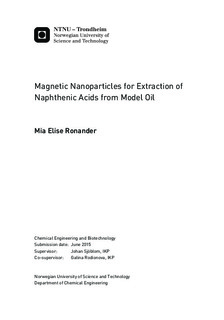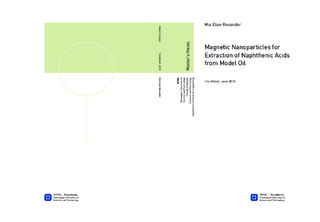| dc.description.abstract | The Master s thesis aims for synthesis of magnetic nanoparticles (MNP), silica-coated magnetic nanoparticles, and their application for extraction of naphthenic acids (NA) from model oil.
The present work is a part of a 2-year Post Doc project supported by a Vista program. The program is funded by Statoil and conducted in close collaboration with The Norwegian Academy of Science and Letters. The goal of the main project is to establish new methods for both preventing formation and facilitating removal of the NA. The newly developed methods will be based on the application of functionalized magnetic nanoparticles (FMN) for extraction of NA before formation of the metal naphthenates as well as their removal.
Commercial magnetic particles with silica cover (SiO2-MAG) were purchased, which could be used just as they are or be directly functionalized. The particles were characterized by digital video microscopy (DVM) to estimate the size of the particles. The diameter was found to be 3,3 μm, and a specific surface area calculated to be 1,4 m2/g. This area was too small for NA adsorption.
Therefore, synthesis of new nanoparticles was required. Fe3O4 MNP were obtained by co-precipitation, and coated with silica via a sol-gel approach. The synthesized MNP had magnetic properties, and were attracted when a magnetic field was applied. They were then characterized by gas adsorption analysis, which enabled the calculation of the specific surface area. The Fe3O4 MNP and Fe3O4/SiO2 MNP had a large specific surface area of approximately 100 m2/g, and the silica covered MNP were used for NA adsorption in octane. The size of the Fe3O4 MNP was estimated to be 12 nm by X-ray diffraction (XRD), and the analysis also confirmed a crystalline structure matching the theoretical Fe3O4 structure.
4-heptylbenzoic acid was used as a model NA and octane was used as model oil for adsorption experiments. A calibration curve for NA in octane was plotted, and adsorption of NA by MNP coated with silica was done to obtain an adsorption curve. | |

